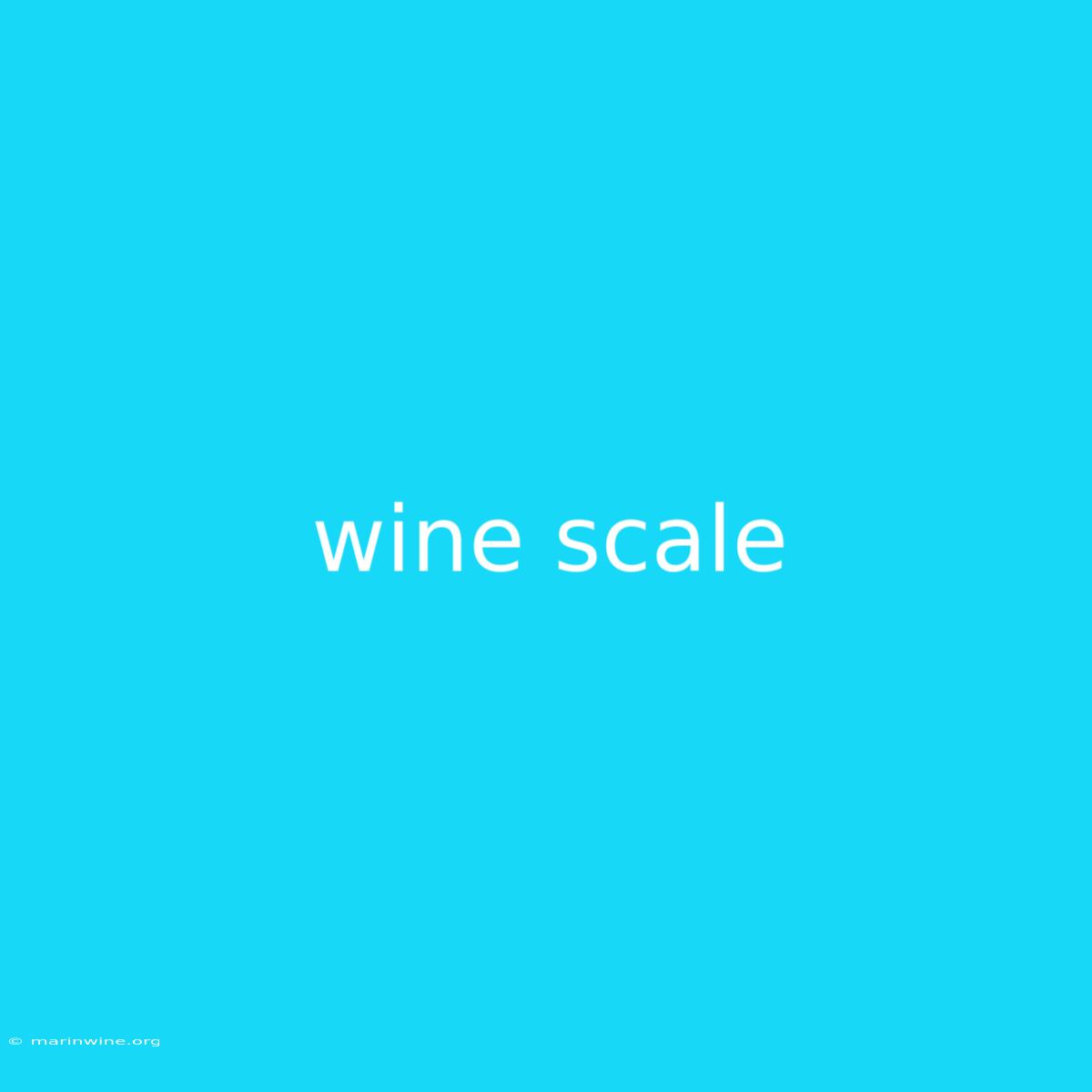Uncorking the Secrets of Wine: A Comprehensive Guide to Wine Scales
Have you ever wondered how winemakers determine the quality of their grapes? It's all thanks to a crucial tool known as the wine scale, which plays a vital role in the winemaking process. This comprehensive guide delves into the fascinating world of wine scales, revealing their importance and impact on the final product.
Why It Matters: Understanding wine scales helps wine enthusiasts, producers, and consumers alike appreciate the complexities involved in crafting a quality wine. This guide explores the diverse range of scales used, their applications, and how they contribute to the overall experience of wine.
Key Takeaways of Wine Scale
| Key Takeaway | Description |
|---|---|
| Wine scales measure various grape qualities. | These include sugar content, acidity, and ripeness. |
| Different scales are used for different purposes. | From assessing grape maturity to evaluating the finished wine, scales provide valuable insights. |
| Wine scales contribute to consistent and high-quality wine production. | By providing objective measurements, they help ensure a predictable and desirable outcome. |
Wine Scales: A Deeper Dive
What are Wine Scales?
Wine scales are instruments used to measure specific characteristics of grapes and wine. These scales utilize various methodologies, including:
- Brix Scale: Primarily measures sugar content (expressed as percentage) in grape juice. Higher Brix indicates higher sugar content, crucial for fermentation and potential alcohol levels.
- pH Scale: Measures the acidity of grape juice or wine. This is essential for balancing sweetness, preserving freshness, and preventing spoilage.
- TA Scale: Measures total acidity in grape juice or wine, indicating the concentration of various acids, influencing flavor and mouthfeel.
- Wine Quality Scales: These subjective scales evaluate the overall quality of wines based on factors like aroma, flavor, balance, and finish.
The Importance of Wine Scales
Wine scales are indispensable tools for winemakers, offering numerous benefits:
- Grape Maturity Assessment: Wine scales help determine the optimal harvest time, ensuring the grapes reach desired ripeness and sugar levels.
- Quality Control: By measuring acidity and sugar levels, scales aid in standardizing wine production and ensuring consistency between batches.
- Flavor Profiling: The data obtained from wine scales helps winemakers understand the nuances of their grapes and create wines with specific flavor profiles.
- Winemaking Decisions: Wine scales provide valuable information that guides key winemaking decisions, including fermentation techniques and aging strategies.
Connecting Wine Scales with Wine Production
Grapes and Sugar Content: The Brix scale plays a crucial role in determining when to harvest grapes. Sugar content is directly linked to the wine's potential alcohol levels. Winemakers use the Brix scale to ensure grapes reach their optimal sugar content, maximizing flavor and alcohol potential.
Acidity and Balance: The pH and TA scales are essential for measuring the acidity of grape juice and wine. Balancing acidity with sweetness is vital for a harmonious wine. Higher acidity often contributes to a fresher, more vibrant character, while lower acidity might lead to a smoother, rounder mouthfeel.
Quality Evaluation: Wine quality scales, often subjective, assess the overall quality of wine based on sensory characteristics. They utilize a point system or a rating system to categorize wines based on factors like aroma, flavor, balance, and finish. These scales, while not absolute, serve as a guide for both producers and consumers.
Wine Scale: An Essential Tool
Wine scales are an essential part of the winemaking process. They provide objective data that helps winemakers control quality, enhance flavor profiles, and create consistent and delicious wines. Understanding the diverse range of wine scales allows both producers and consumers to appreciate the complex world of wine production.
FAQ for Wine Scales
| Question | Answer |
|---|---|
| What is the Brix scale used for? | The Brix scale measures sugar content in grape juice, essential for determining potential alcohol levels and harvest time. |
| How is the pH scale used in winemaking? | The pH scale measures acidity, influencing taste, preservation, and overall balance in wine. |
| What are wine quality scales used for? | Wine quality scales, often subjective, assess the overall quality of wine based on sensory characteristics. |
| Are all wine scales standardized? | While some scales like the Brix scale are widely standardized, others like quality scales might vary based on region or organization. |
| Can I use a wine scale at home? | While professional-grade scales are available, home winemakers can also utilize hydrometers and refractometers for similar measurements. |
| Why are wine scales important for wine drinkers? | Understanding wine scales helps appreciate the complexities behind wine production and the factors influencing flavor and quality. |
Tips for Wine Enthusiasts
- Learn about the different wine scales. Understanding their purpose and application will deepen your appreciation for winemaking.
- Pay attention to acidity levels in wine. Acidity can vary depending on the grape varietal and the winemaking process.
- Experiment with different wines. Explore wines from various regions and grape varieties to discover how acidity, sugar levels, and other factors contribute to the overall taste.
- Research wine quality scales. Learn how different organizations and regions use quality scales to assess wine.
- Engage with winemakers. Ask questions and learn about their approach to winemaking, including the use of wine scales.
Summary by Wine Scale
This article has explored the vital role of wine scales in the winemaking process. By understanding their purpose and applications, we gain a deeper appreciation for the complex world of wine production. Whether you are a wine enthusiast, producer, or consumer, recognizing the importance of these tools empowers you to make informed choices and enjoy wine with a greater understanding of its complexities.
Closing Message: The next time you savor a glass of wine, take a moment to consider the scientific measurements that contribute to its creation. The journey from grape to glass is a testament to the precision and artistry involved in crafting a truly remarkable beverage.

